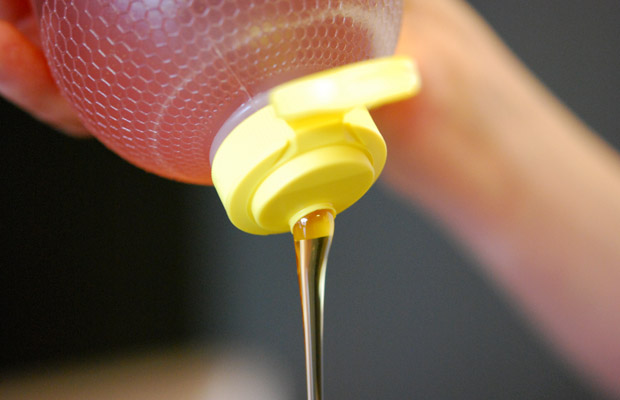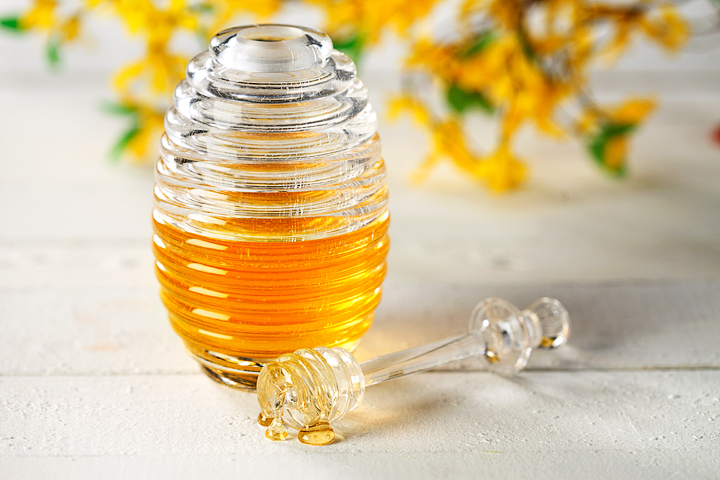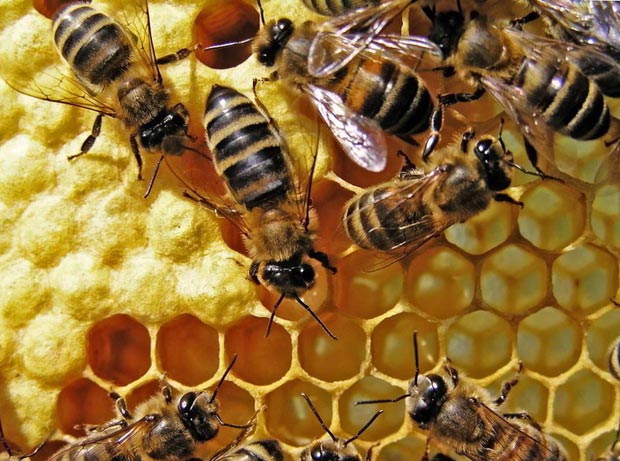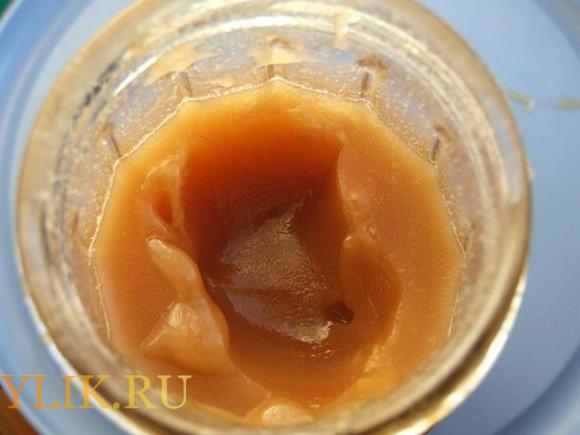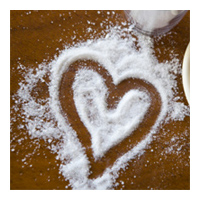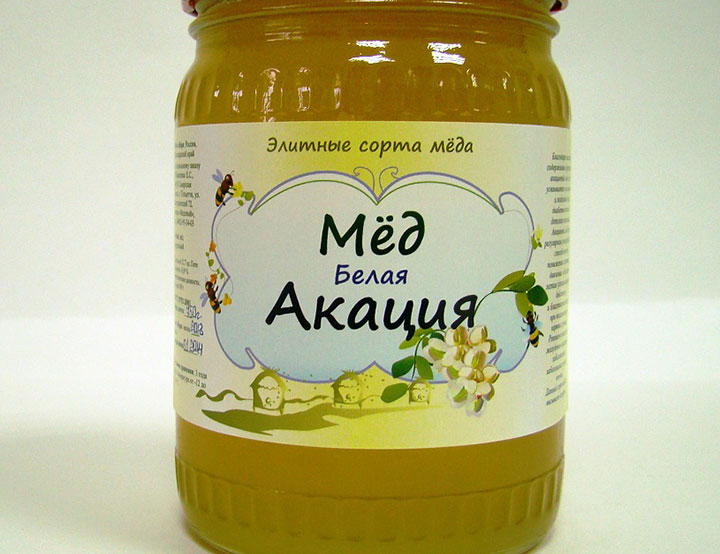Site sections
Editor's Choice:
- What honey is not sugared: varieties, causes
- Symptoms, course, treatment and prevention
- Lecture Topic: Digestive System
- How many grams of honey in a teaspoon and a tablespoon
- Pancreatitis tests: what studies should be done and what do the indicators say
- How to remove cholesterol from the body
- Hyperplasia of the cervix and endometrium: why treatment is necessary
- How much fracture is fused
- How do leaves change in autumn
- All you need to know about pumping honey
Advertising
| Linden honey crystallization. What honey is not sugared: varieties, causes |
|
There are several reasons why honey may not be sugared (crystallized). This effect may not portend anything bad and simply indicate the origin of honey. However, sometimes not sugared honey is of poor quality, which indicates the negligence of the beekeeper. Good honey, but not sugared.So, we will analyze in more detail the option when the honey of normal quality costs a month, two, a year and is not sugared. The essence of the process of crystallization of honey is stored in its composition. More precisely, in the two main constituent elements: glucose and fructose. Glucose crystallizes easily and has a sweet taste. Fructose does not crystallize and it is 2 times sweeter than glucose. In honey with a high content of fructose, fructose envelops crystals of glucose, sucrose and other well-crystallizing sugars, thereby preventing sugar sugaring. If glucose honey contains less than 30%, then such honey does not crystallize at all. There are varieties of honey with a low glucose content, such honey is more liquid (at normal humidity) and crystallizes very slowly. If you have an average room temperature above +23 C, then such honey can stand in the room and year in a liquid state. However, such honey will not deteriorate and will also retain all its qualities and usefulness. The most favorable temperature for crystallization is +10 - +15 C. At higher and lower temperatures, the crystallization of honey slows down. Slow crystallizing include: honey from sage, acacia, chestnut, (not all, depending on the location of the fireweed) and others. Bad honey is not sugared.And now we will consider options in which situations honey remains liquid, but at the same time its quality leaves much to be desired. 1) Not ripe honey. Often, newbie beekeepers, without waiting for the ripening of honey within the framework, pump it out with the aim of earning more profit or simply do not know when the honey has matured. Ripe honey - this is honey, in which all the main reactions to break down complex sugars into simpler ones have passed and from which the bees have evaporated all the excess moisture. When the honey has matured, the bees close the frames with honeycombs with wax caps. When the frame is sealed completely, honey is ready to be pumped out. In unripe honey, a high moisture content, and this partially prevents crystallization. Such honey can exfoliate and ferment in a couple of months. Fermented honey has a pungent and sour smell. 2) Not . Honey is very hygroscopic (able to absorb moisture). In a warm, humid environment, honey absorbs moisture, which in the first case prevents crystallization and can also lead to fermentation. 3) Not natural honey or diluted.Often in our consumer life we \u200b\u200bbuy low-quality products. There are a lot of fakes and honey on the market, someone dilutes honey with sugar syrup, someone adds starch or flour to make the fake as thick and sticky as honey.
4) When heated, the honey becomes liquid. But you can heat it up to +40 C, not more. At higher temperatures, vitamins and all useful properties are lost. Some sellers, in order to give the presentation of honey, heat and overheat it. Honey becomes liquid and loses its crystallization properties. Such honey does not crystallize at all. The smell almost disappears. The color of superheated honey can be described as dark brown amber. Depending on the degree of overheating, honey is either lighter or darker, but a brown tint is always present in this case. Recently faced with a new kind of fake. The Chinese bring some kind of powder in briquettes, either dilute it with water, or with some kind of reagent, and honey is obtained in color and smell that is indistinguishable from natural. The most important thing is that in chem. laboratories, with a surface analysis, the results indicate the naturalness of honey. Tip: How to "make" honey crystallize? If you doubt the quality of the honey you bought due to the fact that it remains liquid for a long time. Find some sugared honey (enough a teaspoon), mix it in a container with a tablespoon of liquid honey, so that you get a homogeneous mass and pour this mixture into a jar of liquid honey. Place the jar in a cool, dry place (+10 - +15 C). In a couple of weeks, if natural honey, it will crystallize. People often ask: “Why is honey not sugared?” In this article I tried to give basic answers to the asked question. And do not be upset if your honey remains liquid for a long time, try to follow the advice given in this article, and you will determine the quality of your jar of honey. 01.03.2017 G. Tseselsky As a beekeeper, I am often asked questions related to the crystallization of honey. But in a nutshell, explaining what this complex physicochemical process is all about is not easy, so in this publication I want to tell you more about this phenomenon, dear readers. I will base my conclusions on personal experience and information obtained from verified sources: books, scientific articles, information from the Russian journal “Beekeeping”. A lot of different information can be found on the Internet, but often the information received from there is unreliable, and sometimes frankly false, and in order to isolate grains of truth, you need to be not only a beekeeper, but live it. Inexperienced readers to understand this stream of information is not easy. I was very amused by an article on one site specializing in the sale of honey via the Internet, which talked about the fast (within two weeks) crystallization of buckwheat and linden honey. Buckwheat honey collected by my pets crystallizes from 2.5 to 8 months, sometimes longer. But we will consider in more detail all the nuances of this natural process below. So, what is it - crystallization of honey. Crystallization or sowing of honey is a natural process of the transition of a substance from one physical state (liquid, syrupy) to another (harder, crystalline) with complete preservation of the valuable qualities of the product. Depending on the size of the crystals, honey is distinguished: creamy consistency - a homogeneous mass, where the crystals are almost impossible to distinguish; fine-grained consistency - crystals up to 0.5 mm, they can be seen in the mass of honey; coarse-grained consistency - crystals larger than 0.5 mm in size, are easily distinguishable in the mass of honey. The bulk of natural honey is a mixture of natural sugars: glucose, sucrose, fructose. These are monosaccharides, which are very easily absorbed by the body (for information: disacchar — ordinary beet or cane sugar — must be cleaved (hydrolyzed) in the body before it enters the blood. Honey crystallizes when glucose settles in the bulk in the form of crystals , hence the name of the process. People usually just say that honey is “thickened” or “sugared”. Consider the main factors affecting the crystallization of honey: sugar ratio in honey; the presence of crystallization centers; the degree of fermentation of honey; mass fraction of water in honey; floristic composition of honey (the influence of honey plants, from which the bees took nectar); storage conditions for honey (temperature, dormancy, mixing). 1. The ratio of sugars in honey So, we will analyze in more detail the option when the honey of normal quality costs a month, two, a year and does not crystallize. The essence of the process of crystallization of honey is stored in its composition. More precisely, in the two main constituent elements: glucose and fructose. Glucose crystallizes easily and has a sweet taste. Fructose does not crystallize at all, and it is 2 times sweeter than glucose. In honey, where there is a high fructose content, it envelops crystals of glucose, sucrose and other well-crystallizing sugars, thereby preventing the start of the honey-setting process. If the glucose content in honey is less than 30%, then such honey will practically not crystallize, and at the same time it will be a good quality product. The ratio of sugar to honey depends on many factors. There are varieties of honey with a low glucose content, such honey is more liquid (at normal humidity) and crystallizes very slowly. If the average storage temperature is above + 23 ° C, then such honey can stand in the room in a liquid state for a year. With proper storage, it will not deteriorate or lose all its qualities and usefulness.
As a result of storage on the surface of honey or along the walls of the container in which it is located, a white coating forms, this phenomenon is called blooming. White plaque is crystallized glucose. If it was formed under normal storage conditions (temperature 14-25 ° С, air humidity 70-80%), then this is a sure sign of mature honey of very high quality, as opposed to the mistaken opinion of consumers that white bloom is sugar that could be fed to bees, not glucose from flower nectar. At a constant temperature, such honey can be stored for many years. Thus, certain proportions of the ratio of sugars in the composition of honey certainly depend on the variety of the product, the habitat of the bees, plants from which they collected nectar, and even on weather conditions during honey collection. Each season, the set of these components will change, therefore, the crystallization rate of honey collected from families located in one place will be different. For example, even a change in air humidity at the time of honey rollback will give different crystallization times - the higher the air humidity, the longer the honey will be liquid. 2. The presence of crystallization centers Crystallization of honey begins with the formation of the so-called germinal crystals. By this name is meant microscopic particles, such as glucose crystals and pollen grains, to which all new crystals are attached. These “primary crystals” are formed, first of all, at the walls and at the bottom of the container and “grow”, adding new sugar crystals to themselves, as a result of which ever larger structures are formed that are joined together. In the end, a single, solid crystalline structure is formed, between the individual links of which are the liquid components of honey. If there are no germ crystals or there are very few of them, then they are first formed from glucose molecules that combine together to form tiny crystals that grow in a specific order. Since only a fraction of the excess glucose molecules is bound by crystals, the latter grow into crystalline stars characteristic of coarse honey. Primary glucose crystals are formed mainly at a temperature of 5-7 ° C, the optimum temperature for the growth of these crystals is 14-15 ° C. Primary crystals can be detected under a microscope in any liquid honey. They can form during the ripening of honey, during its storage, and enter the honey from nectar, which condenses in dry and hot weather, and the sugar contained in it partially crystallizes. In addition, various impurities in the form of pollen grains, proteins, mineral salts significantly accelerate the crystallization process, forming new centers around which new crystals form. 3. The degree of fermentation of honey Everyone watched how, on a summer sunny day, bees circle above the flowers from which they collect sweet nectar droplets. Nectar contains from 40 to 80% water, and for the preparation of honey, bees must remove ¾ of this amount of moisture. This is achieved by the fact that every drop of nectar of the bee is repeatedly transferred from one wax cell to another, third, etc. In addition to this purely physical process, the removal of excess moisture also occurs in the bee’s honey ventricle. Water from nectar is absorbed by the cells of the honey bee’s ventricle, enters the hemolymph, then through the malpighian vessels into the rectum and is removed from the body. In the bee's body, a drop of nectar is enriched with enzymes, organic acids, disinfectants, etc. This is the fermentation of honey. The stronger the bee family, the more working bees and receiving bees in it, the more enzymatic the ability of such a family. Observing families for a long time, I was convinced that, with other conditions being equal and families were at the same point, honey from strong families crystallized much more slowly than from weaker ones. I want to give advice to beekeepers - do not feed your bees with sugar. To break down sugar into natural sugars, the bee spends a lot of enzymes, weakens, it has reduced working capacity and life expectancy. As a result, honey is not saturated enough with enzymes, which affects its quality and benefits for humans. 4. Mass fraction of water in honey The crystallization process of honey is significantly affected not only by the ratio of fructose to glucose, but also the mass fraction of water in its composition - water content. In my apiary, the water content of honey when extracted from sealed honeycombs never went beyond 15.8-16.2%, that is, this is the most stable indicator. Whatever the bee family, weak or strong, sealed honey has water content within the above ranges, although other indicators, for example, diastase number, may differ from each other, even when the bee families are located at one point. With an equal amount of glucose and fructose or a predominance of glucose, honey always crystallizes. The process is much faster if the ratio of the percentage of glucose to the water content of honey is 2: 1 or more. Honey with a water content of 16% and an amount of glucose of 32-35% in a crystalline state is hard as a stone and retain its properties for many years. This can not be said about liquid honey and with a plastic consistency, in the composition of which fructose predominates or an increased content of non-inverted sucrose is observed. If the water content of honey exceeds 20% (unripe honey), then during crystallization it can stratify, which is also facilitated by temperature fluctuations. At room temperature, such honey begins to ferment and does not withstand long-term storage. No doubt, the water content of honey is very important for bees during the wintering period. Sealed honey with water content, which the bees have chosen for themselves, makes it possible to keep them winter supplies, provide themselves and offspring with carbohydrate feed with the necessary enzymes and water. 5. The floral composition of honey (the influence of honey plants, from which the bees took nectar) Depending on the honey plant, the nectar of which was collected by bees, honey varies in color, taste and smell. If honey is obtained from one particular type of plant, then it is called monofleur, usually it is given the name of this plant - for example, linden, cypress, buckwheat, sunflower. If the bees collected nectar from different plants, then such honey is usually called polyfler (mixed), or simply floral, motley. It is necessary to realize that it is practically impossible to get honey from one melliferous plant - a lot of honey plants usually bloom simultaneously next to an apiary.
Slowly crystallized honey collected by bees from acacia, sage, cherry, euonymus. Honey from linden, raspberries, buckwheat or fireweed, if stored properly in a tightly sealed container at a temperature of 15 ° C, also does not crystallize for quite some time. Honey collected by bees only from white acacia nectar and fireweed (ivan tea) may not crystallize over the years. Although absolutely monoflore varieties of honey are very rare. Impurities of nectar from other honey plants are always present. Depending on the type of honey, the crystallization process can take place both very quickly and slowly, up to a year or more. 6. Storage conditions for honey (temperature, dormancy, mixing) Natural honey, sealed in honeycomb cells in the hive, is there at a temperature of 20-30 ° C and always remains liquid. On such honey the bee family winters. The exception is rapeseed honey, which crystallizes even in honeycombs located in the hive, and heather honey. Such honey must be completely rolled back before crystallization occurs. If you do not do this and leave it for the winter, the bee family will die of starvation, because in order to transfer crystallized honey to a liquid state suitable for consumption by insects, water is needed. In winter there is no water and there is no place for the bee to take it, since during this period it does not leave the hive, and if it flies out, it will die from the cold. Consequently, the temperature regimes of its storage have an obvious effect on the crystallization of honey. The most favorable temperature for this is + 14-15 ° C. If it is below + 4 ° С and above + 27 ° С, honey practically does not crystallize. If the storage temperature is below + 4 ° C, then the viscosity of honey increases, the molecular diffusion rate decreases and the formation of germ crystals ceases. The volume of honey is reduced by 10%. The reason for this is the high concentration of sugars, which significantly reduces the freezing point. This effect can be observed already when storing honey at a temperature of + 10 ° C and below. At elevated storage temperatures, honey crystallizes to form large crystals. With increasing temperature, the volume of honey expands, and at a temperature of + 23 ° C the volume increases by 5%. If it is above + 27 ° C, glucose crystals begin to partially dissolve, honey becomes more liquid. It should be noted that sharp temperature fluctuations significantly accelerate the crystallization process - there are changes in the degree of supersaturation of sugar solutions. Therefore, if storage is carried out at an even temperature and the container is properly closed, honey may not crystallize for a long time. Also, the rate of crystallization is affected by mechanical stress. When honey is mixed, partial coalescence of glucose crystals occurs, their number increases, so the crystallization process proceeds faster. When honey is filtered through fine-mesh sieves, the number of crystallization centers decreases, which slows its flow. If you doubt the quality of the honey you bought due to the fact that it remains liquid for a long time, you can simply check its naturalness in a simple way. Find a little candied honey (enough a teaspoon), mix it in a small container with a tablespoon of liquid honey so that a homogeneous mass is obtained and mix this mixture with the remaining liquid honey. Put the jar in a dry, cool place (+ 8-15 ° C). After a few weeks, if the honey is natural, it will certainly thicken, as the crystals of candied honey trapped in liquid honey will start the accelerated crystallization process. Crystallization itself should take place gradually and evenly, throughout the entire volume of the tank.
Should honey remain liquid like water and not thicken?Natural, without additives, it necessarily sugar, the only difference is when. But there are well-known exceptions, for example, acacia. Pure acacia may not thicken for years, of course, with proper storage. So say the beekeepers with experience. Liquid honey, if natural, will remain so for at least a month or two, and then may begin to thicken. It is known that the density of a substance is determined by glucose in its composition. In fact, the more glucose, the higher the chances of an early crystallization. If the substance is the record holder for the presence of fructose, and not glucose, it will take a long time to thicken. "Fructose" champions among honey varieties - acacia, fireweed. What are the reasons for this process?Why is honey liquid like water? What is the reason? First of all, one cannot reject the option of falsification. It's a shame, but a fact - some unscrupulous sellers deliberately breed honey or heat candied honey so that it becomes liquid again. Moreover, such heating certainly does not benefit the product. How to distinguish liquid real honey from fake or diluted?
A high-quality mass should smell, not with flowers, namely honey, wax, honeycombs. If you have been to an apiary at least once in your entire life, this smell cannot be confused with anything. And there are exceptions - honey from Ivan tea. However, it can be found in its pure form in the markets quite rarely, and even this fragrance is not familiar to everyone. If the liquid pours from a spoon like water, splashes, and the trickle breaks off too quickly, look for another seller. Such goods are diluted with syrup, and also immature. Having bought an unripe variety, you risk becoming the owner of a fermented product that either acquires a sour taste or lets foam. But to sin on all liquid types of honey is also not worth it. A rarefied state for the time being is the norm for the results of bee labor. Perhaps the matter is also how the mass is stored at home. Even temperature, without differences in cold allows honey to maintain a normal state.
Is it possible to affect the crystallization of honey?If you really want to keep the liquid state longer, the cans can be placed at a uniform temperature. In no case do not put them in the cold or on the balcony in winter, then you won’t have to ask “why honey does not thicken”. Crystallization can be either slowed down or accelerated. Suppose you like to eat a sugared product, but your purchase is like water in its condition. You must try to thicken the substance. You can do this with a few tricks:
If crystallization has not yet occurred, there are few options: either the storage is so comfortable that without stirring the product hardens very soon, or there is fake before you. Only natural mass with a high glucose content, stored at room temperature without stirring, may not thicken for a long time. Video "How to choose high quality honey"An educational video about the right choice of a quality product - how to choose and what to pay attention to. When sugar crystals appear, honey begins to sugar. Honey is 90% glucose and fructose. Sugaring honey does not say anything about its quality. Natural honey crystallizes (beekeepers say "sits down") from two weeks to two months, but there are exceptions. I bought a jar of honey at the fair, four months passed, and he did not sugary. Could it be or is it a fake? If there is a lot of fructose, honey can remain in a liquid state for more than a year. The crystals are explained by the fact that fructose envelops glucose. I know for sure that we have natural honey! I have buckwheat honey, relatives from Altai brought it. At the bottom, something like thickened, and so on top, liquid. Elena, this is because honey is partially immature. Natural ripe honey should be sugar already on the fifth day after pitching, and it is healing. On the other hand, after filling the honeycombs with bees, no one wants to leave the hive to ripen honey for ten days, since during this time one can take another “crop” (the pursuit of profit). So do not look for real mature honey, but do beekeeping yourself, you just need to learn this correctly.
Unripe honey quickly soups. It is already March, and our honey does not crystallize. I still have liquid honey i.e. not sugared. It has been 10 months already, Honey is collected from meadow herbs and forest. I am a beekeeper, collecting only mature, sealed honey. I want to say that my honey does not crystallize at all (forbs). It often happens that many people, opening a jar of honey in winter, are upset when they see a white “hat” on the top layer of a sweet product. Indeed, in fact, the crystallization of honey is a normal natural process that is characteristic of almost every type of natural product and is evidence of its high quality.
Why? There is one secret of this product - only “settled” honey, that is, which succumbed to the thickening process, retains all its useful properties. Each type of liquid honey by the beginning of winter should already show the first signs of crystallization. Moreover, different types of honey after crystallization may look different: some resemble butter, others are ordinary sugar grains. It should be remembered that honey is a living product. Honey in honeycombs is sugared a little longer, for about 4-6 months of storage. It is no secret that this ratio is different in different types of honey, therefore, each type of this sweetness has its own dates for the onset of sugarization. In this case, the more glucose is contained, the faster it "sits down". Crystallization of bee honey is a natural phenomenon. Liquid amber dessert changes its structure and color over time. A few months after collection, it becomes thick, heterogeneous, loses transparency and turns white. The beneficial qualities of honey do not suffer from this, but often buyers prefer a liquid product. After all, such a dessert is more convenient to spread on sandwiches, add to drinks, use for baking and home cosmetics. Therefore, many will be interested to know if it is not sugared and why it retains its original appearance. The fact that honey is sugared over time is not surprising. This is a natural process, talking about the naturalness of the product. Depending on the consistency that dessert acquires over time, there are three types of crystallization:
What honey can remain in its original form for a long time? The ability of natural honey to sugar depends on the ratio of its two important components - glucose and fructose. Crystallization of the product occurs precisely due to glucose, therefore, varieties of honey with a predominance of fructose retain their liquid consistency and a pleasant golden hue much longer. But often this is not only this, there are other reasons why honey is not sugared. We list the main ones:
Important! To protect yourself from fakes, learn to identify overheated honey. After heat treatment, it acquires a darker shade and loses a pleasant tart aroma characteristic of an unprocessed product. Do not forget that early spring honey is often faked. The fact is that in appearance the early varieties resemble honey, which the bees produce after feeding sugar. Distinguishing a natural May product is much easier in early autumn, when it is infused and shrinkage begins. Quality checkingWhatever kind of honey you choose, remember: a natural treat cannot always remain liquid. Over time, at least slight signs of crystallization should appear in it. Therefore, pay attention to the bottom of the vessel - this is where the first precipitate forms over time. But what to do if the honey purchased on the market does not crystallize much longer than usual and there are doubts about its naturalness. How to check the quality of flower dessert in this case? Find a teaspoon of the old, candied product, add a little liquid to it and mix until a homogeneous composition is obtained. Then pour this mixture into a bowl of honey and leave it in a cool, dry place. If after two weeks the product began to sugar, then it is natural. Liquid speciesThe tendency of honey to be sugared depends on which honey plant prevails in it. Some varieties begin to change the consistency within a couple of months after harvest, while others remain in liquid form even after a year. The following types of honey are most slowly sugared:
If you like liquid transparent dessert, try to purchase one of the listed varieties and store it under optimal conditions. Then you don’t have to spend effort on melting honey, and you can enjoy a healthy, unprocessed product for a long time. |
| Read: |
|---|
Popular:
What drugs lower cholesterol
|
New
- After how much plaster is removed
- Lady's hand kissing allowance
- Summary of the lesson "first aid for bruises and fractures"
- Food Sources of Ascorbic Acid
- The most dangerous poison for humans
- We study a tree, playing: riddles about a birch
- Plaster cast care
- How to moisturize dry skin in the winter
- Fish oil Biafishenol: instructions for use
- How to clean the apartment yourself from damage

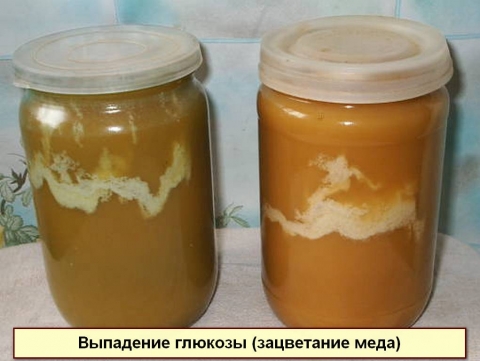
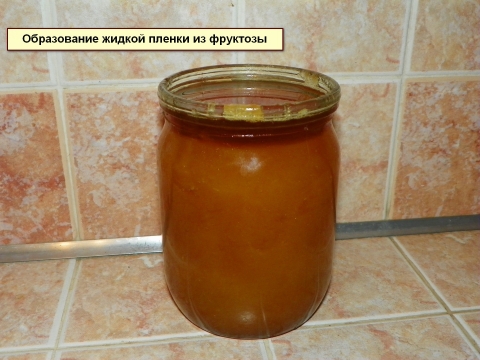 Often, when the storage temperature of honey is increased, a liquid film of fructose is formed on the surface, and the accumulation of liquid fructose in solid crystallized honey can be observed if a depression is made on its surface (for example, scoop the honey with a spoon). After a while, the resulting funnel will be filled with liquid fructose. This phenomenon is normal and does not mean that the honey has deteriorated or has lost its quality. Now, if the contents of the can are stratified into fractions: the lower part of the container is crystallized honey, and the upper half is the liquid fraction, then you should think about the quality of the product. Often such a picture is a sign of the immaturity of honey, or a mixture of honey with any other components.
Often, when the storage temperature of honey is increased, a liquid film of fructose is formed on the surface, and the accumulation of liquid fructose in solid crystallized honey can be observed if a depression is made on its surface (for example, scoop the honey with a spoon). After a while, the resulting funnel will be filled with liquid fructose. This phenomenon is normal and does not mean that the honey has deteriorated or has lost its quality. Now, if the contents of the can are stratified into fractions: the lower part of the container is crystallized honey, and the upper half is the liquid fraction, then you should think about the quality of the product. Often such a picture is a sign of the immaturity of honey, or a mixture of honey with any other components.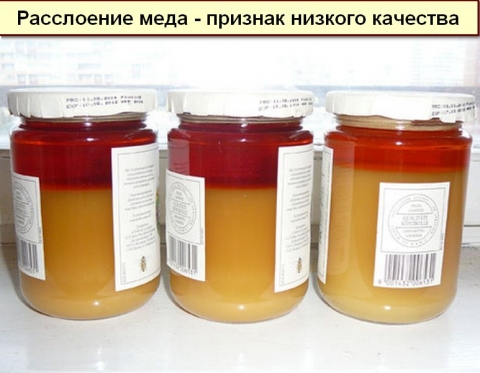
 Different botanical varieties of honey have different crystallization rates. Honey from the flowers of the dandelion "sits" most quickly (from about 2-3 days to 1 week), forbs (depending on the honey plants from which it was collected) "sits" two to three months after rolling back from the honeycombs. The crystallization process of honey collected from rapeseed, mustard, colza (cruciferous family), sainfoin, sow thistle, and alfalfa proceeds rapidly.
Different botanical varieties of honey have different crystallization rates. Honey from the flowers of the dandelion "sits" most quickly (from about 2-3 days to 1 week), forbs (depending on the honey plants from which it was collected) "sits" two to three months after rolling back from the honeycombs. The crystallization process of honey collected from rapeseed, mustard, colza (cruciferous family), sainfoin, sow thistle, and alfalfa proceeds rapidly.